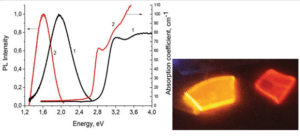E Kolobkova, N Nikonorov – Quantum-dot Based Light-emitting Diodes, 2017
Abstract
In this study, the luminescent properties of the CdS(Se) quantum dots (QDs) with the mean size of 2–4 nm, the (PbS)n/(PbSe)n molecular clusters (MCs) and PbS(Se) quantum dots (QDs) with the mean size of 2–5 nm embedded in the fluorine-phosphate glass are investigated. The dependence of the photo luminescence absolute quantum yield (PL AQY) on the sizes of the CdS(Se) QDs are studied. It is found that the PL AQY of the CdSe QDs increases monotonically to its maximum height and then falls down. The PL AQY of the CdS(Se) QDs can reach 50–65%. Luminescence of (PbS)n/(PbSe)n MCs embedded in fluorine-phosphate matrix and excited by UV radiation is obtained in the visible spectral region and its absolute quantum yield was up to 10%. The PbSe QDs have broadband photoluminescence with quantum efficiency about five times more than MCs (~50%) in the spectral range of 1–1.7 µm. Glasses doped with PbS(Se) QDs provide potential application as infrared fluorophores, which are both efficient and possess short life times. The glass matrix protects the QDs from external influence and their optical properties remain unchanged for a long time.

… edge PL is negligibly weak (Figure 3). The emission spectrum of samples is dominated by “deep trap” emission, strongly red shifted from the band edge (Figures 3 and 4). For registration of the emission spectra was used an EPP2000-UVN-SR (Stellar Net) fiber spectrometer. …





